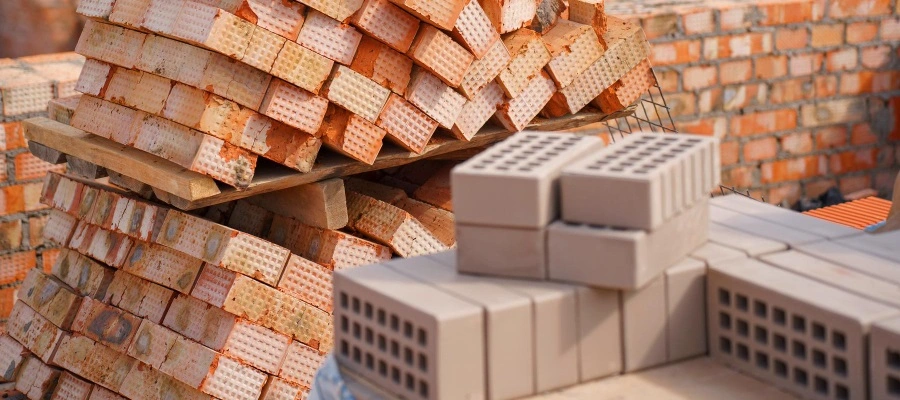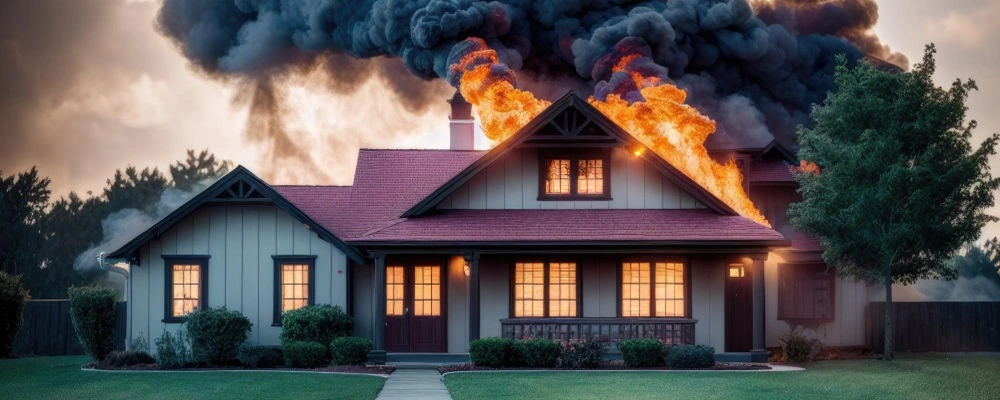Recently, architects and engineers worldwide have been planning, designing, and constructing buildings, keeping in mind the safety of occupants in case of an outbreak of fire. A fire starts igniting all the combustible materials in the surrounding areas. If you fail to check it on time, it might spread to other parts of the buildings, leading to the collapse of the building.
Remember, fuel always causes and aggravates fire. The duration and temperature of fire are the primary factors on which the quantum of damage depends. Therefore, it’s essential for builders to use fireproof construction materials, as they never cause heavy smoke. Although one cannot be absolutely safe from fire, one can take certain measures, including using fire-resistant materials during construction.
Brick & Bolt delves into fire-resistant building materials in this blog, focusing primarily on the top five worldwide fire-resistant materials builders use. Whether the building experiences the searing heat of a conflagration or the slow burn of a smoking fire, these materials stand as stalwart guardians, offering protection and peace of mind to the builders and occupants alike.
Fire-Resistant vs. Fire-Resistive Construction
Fire-Resistant Construction
Fire-resistant construction decelerates the spread of fire, as the materials used in construction take longer to pass the fire. The goal of using such materials is to offer more time for the occupants to vacate the building. The longer it takes the fire to affect the materials or structure, the more time the occupants have to escape. The fire-resistant building materials do not combust and self-extinguish after eliminating the ignition source.
The materials are rated based on how long they hold up during a controlled burn test. Mostly, exterior doors and drywall have such ratings. Doors have a rating of 30 or 60 minutes, whereas dry walls have ratings of 30, 60, and 90 minutes. Remember, the rating does not indicate how long the material holds up in real-world scenarios. The fire’s temperature and the material’s condition often affect the performance and the time it holds up.
Fire-Resistive Construction
On the other hand, fire-resistive construction refers to a building and construction method specifically engineered to withstand and contain the spread of fire. This type of construction uses fire-resistant materials, including fire-rated doors, walls and floors. Builders also use fireproof coatings and structural designs that hinders the progress of flames and heat in case of fire. The primary goal of the construction is to create a structure that withstands fire, maintain its structural integrity and protect people and property during a fire emergency.
Best 5 Fire-Resistant Building Materials for Construction

Today’s infrastructure demands a blend of innovative construction styles with vigorous technologies. Builders must use the best quality, durable construction and building materials to achieve this. With the increase in the demand for skyscrapers and huge infrastructure projects, the demand for the best quality products is also increasing. The Indian Government, in 1990, took an initiative under the Building Materials and Technology Promotion Council (BMPTC) to encourage and promote energy-efficient, environmentally feasible and sustainable building materials.
The best five flame-retardant materials for construction include the following:
1. Concrete
Concrete has long been the most common and widely used building material in the construction industry. Different types of concrete are available; hence, its worldwide use is double that of steel, wood, plastic, and aluminium combined. Besides being a bad conductor of heat, concrete is a good fire-resistant material. Although it doesn’t have a melting point, it gains much strength after achieving certain degrees of temperature.
Though its strength decreases considerably when exposed to high temperatures, concrete never loses its strength when heated up to 250°C. Concrete consists of various materials, including cement, aggregates, water, steel, and other mixtures, which is why it doesn’t have a fixed thermal resistance capacity. Concrete’s fire-resistance degree depends on the aggregates’ nature and density. Reinforced concrete structures can resist fire for about 1 hour at 1000°C.
Moreover, concrete has low heat absorption power. Therefore, even if the outer temperature of concrete reaches 500, the internal temperature of the inner concrete remains relatively low. A concrete structure weakens only when the fire is long and intense. In case of a fire, the concrete experiences dehydration, causing the aggregates to expand and the cement to shrink.
2. Bricks
Bricks are the most common and favoured material for construction worldwide. Builders utilize bricks in the construction of the walls, lintel, arch, retaining wall and cavity wall, amongst others. Besides, bricks give an aesthetic appearance to the structure. The best builders tend to use the best quality bricks. These bricks are fireproof, as they have the capacity to withstand exposure to fire for a long. As poor conductors of heat, bricks withstand higher temperatures up to 1300°C without causing any serious effect on the building.
With a melting point of about 2800°C, fire bricks emerged as the most preferred choice of builders for fire-resisting construction. The degree of fire-resistance in bricks depends upon several factors, including the size of the bricks, composition of brick clay, and construction method. Although bricks have their structural limitations for use in the building, brick masonry proved to be the most suitable for safeguarding the structure against fire hazards.
3. Plaster or Mortar
As an incombustible and fire-retardant material, plaster is one of the best fireproof materials builders use. They use the material to protect building walls and ceilings from fire risks. Builders prefer using cement plaster compared to lime plaster. Builders apply the plaster in thicker layers to increase the fire resistance of the plaster to fire hazards. Alternatively, you can also increase its resistance capacity by reinforcing the plaster with metal lathes.
Besides cement and lime plaster, builders use gypsum plaster on steel columns and other steel structures to increase their fire-resistance power. Builders prefer using a combination of cement mortar with Surkhi or Pozzolana for fire resistance. However, today, vermiculite plaster is the most effective fireproof building material for builders. Vermiculite’s low density and insulation properties make it ideal for building boards.
4. Glass
Due to its low thermal conductivity, builders consider glass one of the best flame-resistant construction materials. With a melting point between 1400°C and 1600°C, it experiences negligible volume change during expansion and contraction. A sudden and extreme change in temperature causes fractures and cracks. However, when glass is reinforced with steel wire netting, such as in wired glass, the fire resistance increases.
Moreover, its tendency to fracture with sudden temperature changes is minimized. Reinforced glass has a higher melting point. Therefore, builders use it to make fire-resistant doors, skylights, and windows. In the construction industry, glass ceramic can tolerate high temperatures, making it suitable for fireproof doors.
5. Steel
For several years, builders have been using steel to build high-rise commercial and residential buildings. They use steel in the beams, columns, lintels, roofs, and ceilings. Steel is also used in heating and cooling equipment and interior ducting. Several building contractors around the globe are using steel in internal fixtures and fittings, including stairs, rails, and shelving.
Besides being non-combustible, steel is a fire-resistant building material. As the temperature increases, steel becomes soft, reducing tension and compression effects. At a temperature of 600°C, steel’s strength gets reduced to only one-third of its value at normal temperatures. Whenever you use water to extinguish a fire on a steel structure, it tends to contract, twist and distort, endangering the stability of the entire structure.
Conclusion
As home needs increase, builders become more responsible for the environmental impact on future generations. Proper selection of fire-resistant building materials and construction methods is crucial in mitigating fire danger. Brick & Bolt, a trustworthy tech-enabled construction company, ensures the use of high-quality fire-resistant construction materials and a smooth and efficient process for building your dream home. The team of proficient experts provides incredible construction services without compromising the quality of resources and building materials. From selecting designs to tracking project progress in real-time, with Brick & Bolt, you have everything at your fingertips.

